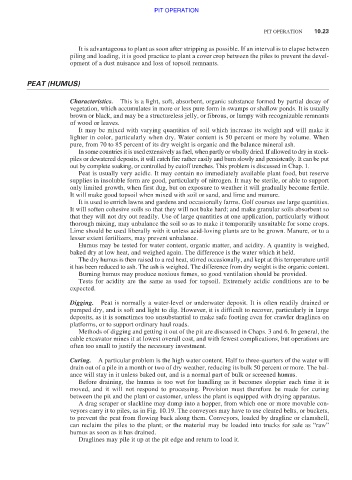Page 517 - Moving the Earth_ The Workbook of Excavation
P. 517
PIT OPERATION
PIT OPERATION 10.23
It is advantageous to plant as soon after stripping as possible. If an interval is to elapse between
piling and loading, it is good practice to plant a cover crop between the piles to prevent the devel-
opment of a dust nuisance and loss of topsoil remnants.
PEAT (HUMUS)
Characteristics. This is a light, soft, absorbent, organic substance formed by partial decay of
vegetation, which accumulates in more or less pure form in swamps or shallow ponds. It is usually
brown or black, and may be a structureless jelly, or fibrous, or lumpy with recognizable remnants
of wood or leaves.
It may be mixed with varying quantities of soil which increase its weight and will make it
lighter in color, particularly when dry. Water content is 50 percent or more by volume. When
pure, from 70 to 85 percent of its dry weight is organic and the balance mineral ash.
In some countries it is used extensively as fuel, when partly or wholly dried. If allowed to dry in stock-
piles or dewatered deposits, it will catch fire rather easily and burn slowly and persistently. It can be put
out by complete soaking, or controlled by cutoff trenches. This problem is discussed in Chap. 1.
Peat is usually very acidic. It may contain no immediately available plant food, but reserve
supplies in insoluble form are good, particularly of nitrogen. It may be sterile, or able to support
only limited growth, when first dug, but on exposure to weather it will gradually become fertile.
It will make good topsoil when mixed with soil or sand, and lime and manure.
It is used to enrich lawns and gardens and occasionally farms. Golf courses use large quantities.
It will soften cohesive soils so that they will not bake hard; and make granular soils absorbent so
that they will not dry out readily. Use of large quantities at one application, particularly without
thorough mixing, may unbalance the soil so as to make it temporarily unsuitable for some crops.
Lime should be used liberally with it unless acid-loving plants are to be grown. Manure, or to a
lesser extent fertilizers, may prevent unbalance.
Humus may be tested for water content, organic matter, and acidity. A quantity is weighed,
baked dry at low heat, and weighed again. The difference is the water which it held.
The dry humus is then raised to a red heat, stirred occasionally, and kept at this temperature until
it has been reduced to ash. The ash is weighed. The difference from dry weight is the organic content.
Burning humus may produce noxious fumes, so good ventilation should be provided.
Tests for acidity are the same as used for topsoil. Extremely acidic conditions are to be
expected.
Digging. Peat is normally a water-level or underwater deposit. It is often readily drained or
pumped dry, and is soft and light to dig. However, it is difficult to recover, particularly in large
deposits, as it is sometimes too unsubstantial to make safe footing even for crawler draglines on
platforms, or to support ordinary haul roads.
Methods of digging and getting it out of the pit are discussed in Chaps. 3 and 6. In general, the
cable excavator mines it at lowest overall cost, and with fewest complications, but operations are
often too small to justify the necessary investment.
Curing. A particular problem is the high water content. Half to three-quarters of the water will
drain out of a pile in a month or two of dry weather, reducing its bulk 50 percent or more. The bal-
ance will stay in it unless baked out, and is a normal part of bulk or screened humus.
Before draining, the humus is too wet for handling as it becomes sloppier each time it is
moved, and it will not respond to processing. Provision must therefore be made for curing
between the pit and the plant or customer, unless the plant is equipped with drying apparatus.
A drag scraper or slackline may dump into a hopper, from which one or more movable con-
veyors carry it to piles, as in Fig. 10.19. The conveyors may have to use cleated belts, or buckets,
to prevent the peat from flowing back along them. Conveyors, loaded by dragline or clamshell,
can reclaim the piles to the plant; or the material may be loaded into trucks for sale as “raw”
humus as soon as it has drained.
Draglines may pile it up at the pit edge and return to load it.

